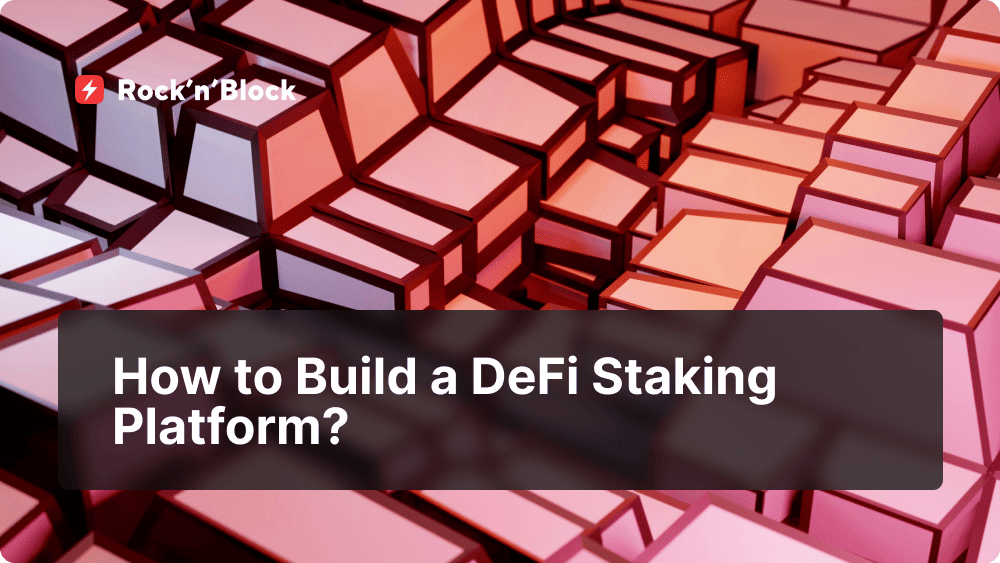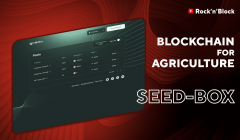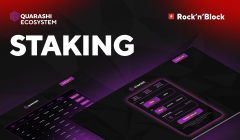How to Build a DeFi Staking Platform?
03 May 2024Staking platform development holds significant importance for project owners in the decentralized finance space. Encouraging investors to hold tokens crucial for DeFi projects for several main reasons.
-
Increased token demand: Motivating investors to hold tokens can lead to a reduction in circulating supply, thereby increasing demand. This can potentially drive up the token's price due to scarcity, benefiting early investors and holders.
-
Resistance to market manipulation: When a significant portion of tokens is held by long-term investors, the project may be less susceptible to short-term price manipulation by speculative traders. This can contribute to a healthier and more resilient ecosystem for the dApp project.
-
Ecosystem expansion: As more investors hold tokens, they become potential advocates for the project, helping to attract new users, developers, and partners to the ecosystem. A growing network effect can lead to increased adoption and utility for the project's tokens.
-
Value accrual mechanisms: Some dApp projects design tokenomics to include mechanisms such as staking rewards, dividends, or buyback programs for token holders. These mechanisms incentivize holding tokens by offering tangible rewards or a share of the project's profits, further motivating investors to retain their holdings.
In this article, we will explore the essential steps and considerations involved in creating a DeFi staking platform, from tokenomics to deployment. This guide will provide you with the knowledge and insights necessary to begin building your own staking platform.

Table of Contents:
-
The Emergence of Staking Development for Crypto Tokens
-
What Is Staking Development
-
Types of DeFi Staking
-
Steps To Create a Staking Platform
-
1. Design Tokenomics
-
2. Define the Staking Mechanics
-
3. Write Technical Assignment and Design The Interface
-
4. Build DeFi Staking Platform
-
5. Test and Quality Assurance
-
6. Security Audit
-
7. Mainnet Deployment
-
8. Manage and Maintain Your DeFi Staking Platform
-
-
Conclusion
The Emergence of Staking Development for Crypto Tokens
The emergence of staking development has been driven by the critical need for sustainable tokenomics within blockchain ecosystems. Staking development has emerged as a prevalent and effective method to incentivize token holders to retain their assets and address the negative effects of investors dumping tokens. In the following sections, we will explore the intricacies of staking development for crypto projects, including its mechanisms, benefits, and impact on decentralized finance applications.
What Is Staking Development
DeFi staking involves locking crypto assets in a smart contract, providing investors with rewards that serve as passive income. This process not only supports the project but also offers investors an opportunity to earn additional income by contributing to the ecosystem's growth and stability through their participation in staking.
For projects, token locking is a way to temporarily withdraw tokens from free circulation by blocking them on a smart contract.
For investors, it is an opportunity to earn additional income.
Benefits of Staking Development for Crypto Projects
The staking platform development has many advantages for project owners. The most common advantages are listed below.
1. Token lockup and reduced selling pressure: Staking requires participants to lock up their tokens for a certain period, reducing the circulating supply available for trading. This lockup mechanism can help mitigate downward selling pressure on the token's price, promoting price stability and supporting the sustainability of the project's tokenomics.
2. Token demand and value appreciation: Staking programs can create demand for the native token as participants are incentivized to acquire and hold tokens for staking purposes. This increased demand can potentially drive up the token's value, benefiting the project's tokenomics by increasing its market capitalization and attractiveness to investors.
3. Community engagement and loyalty: Staking programs incentivize token holders to actively participate in network activities such as staking, governance voting, and community initiatives. This increased engagement fosters a loyal and committed community of token holders, which can enhance the project's tokenomics by fostering trust, loyalty, and long-term support for the project.
4. Ecosystem growth and utility: Staking programs can incentivize developers to dApp development on the project's platform by providing opportunities for token rewards or participation in network governance. This ecosystem growth enhances the utility and value proposition of the project's tokenomics by expanding the range of applications, services, and use cases available within the ecosystem.
5. Incentivized liquidity provision: Some staking programs incentivize liquidity providers by offering rewards or benefits for supplying liquidity to decentralized exchanges or liquidity pools. This incentivized liquidity provision enhances the project's tokenomics by improving liquidity, reducing slippage, and enhancing the overall trading experience for token holders.
Types of DeFi Staking
When embarking on the journey to create a staking platform, developers can explore various staking mechanisms, each offering unique features and benefits:
Staking
Investors have an option to hold their tokens within a dApp and receive interest in the form of yields in exchange.
Farming
Yield farming development, often referred to as liquidity mining, is a DeFi strategy that allows crypto holders to earn passive income by providing liquidity to various DeFi platforms. The process revolves around participating in liquidity pools, which facilitate activities such as lending, trading, or borrowing, and they rely on the contribution of users who lock their liquidity provider (LP) tokens to provide liquidity. In return, investors receive rewards in the form of additional tokens, interest, transaction fees, or a share of the platform's income.
Explore Why Do DeFi Platforms Need Yield Farming Development?
NFT Staking
Unlike traditional staking where users lock up fungible tokens, NFT staking allows users to stake unique digital assets such as digital art, collectibles, or virtual real estate. This enables NFT enthusiasts to earn rewards and unlock exclusive NFT-related features.
Staking development for crypto projects presents a compelling opportunity to harness the power of decentralized finance and empower participants to actively contribute to blockchain networks while earning rewards. By building a staking platform, developers can leverage the benefits of staking to incentivize liquidity provision, and foster community engagement in the ever-expanding DeFi ecosystem.
Steps To Create a Staking Platform
Creating a staking platform offers a promising opportunity to leverage blockchain technology and contribute to the growing DeFi solutions ecosystem. This paragraph outlines the key steps involved in building a staking platform.
1. Design Tokenomics
To build a staking platform you need to create a well-thought-out tokenomics. Tokenomics refers to the economic model governing tokens distribution, supply, and utility within the project’s ecosystem.
The first step in creating a staking platform is to establish the tokenomics, particularly regarding the allocation of tokens for community rewards. Determining how many tokens will be dedicated to community awards is crucial as it directly impacts the platform's incentive structure and user participation. When distributing tokens for rewards, the potential impact on token value must be considered. Too generous or too frequent distribution of rewards may result in an oversupply of tokens or their immediate sale, causing their value to drop. Therefore, the percentage and schedule of rewards should be well thought out to preserve the value of the tokens and prevent a sharp drop in their price.
Careful consideration should be given to strike a balance between incentivizing user engagement and ensuring the long-term sustainability of the platform. By defining clear guidelines for token allocation, developers can effectively incentivize community participation and foster a vibrant ecosystem around the staking platform.
2. Define the Staking Mechanics
In the staking platform development, the mechanics of staking play a pivotal role in shaping user interactions and rewards distribution. It's essential to carefully consider factors such as staking periods, reward calculation methods, and distribution mechanisms. Determining the duration of staking periods establishes the timeframe for which users lock their tokens, impacting the liquidity of the platform and the frequency of rewards distribution.
Defining how rewards will be calculated influences the attractiveness of staking for users.
In DeFi staking development, rewards are often distributed in the form of additional tokens or fees collected within the protocol. Rewards are typically calculated based on various factors, including the number of users staking and the percentage of their stake in the total pool, the duration of participation, and the overall activity within the protocol. Smart contracts automate the process of reward calculation, ensuring transparency and accuracy in the distribution of incentives to participants.
There are different models to calculate the rewards:
1. APY (Annual Percentage Yield) and APR (Annual Percentage Rate):
APY reflects the annualized return, accounting for compounding, while APR represents the simple annualized rate of return. These metrics provide insights into the profitability of staking activities.
2. Longer Pays Better/Bigger Pays Better:
Protocols may offer higher rewards to participants who stake their assets for extended periods or contribute larger amounts, encouraging sustained participation and larger capital injections.
3. Entry Policy/Exit Policy:
Entry policies may require minimum deposits or lock-up periods, while exit policies may stipulate withdrawal fees or cooldown periods to maintain liquidity stability.
4. Multipliers:
Factors added to rewards to encourage specific behaviors or contributions, such as providing liquidity to pools with lower liquidity levels or staking a specific token.
5. Governance Rewards:
Participants receive additional tokens or voting power for actively engaging in the governance process of the protocol, incentivizing user participation in decision-making.
By meticulously planning the mechanics of staking, developers can design a platform that incentivizes long-term participation, fosters community engagement, and ensures a fair and transparent rewards system.
3. Write Technical Assignment and Design The Interface
On the way to create a staking platform, drafting a comprehensive technical assignment and designing the interface are critical steps to ensure the project's success. The technical specifications outline the platform's specifications, functionalities, and requirements, serving as a roadmap for developers and stakeholders. It should detail the smart contract development, blockchain integration, and security protocols. It should also define the staking mechanics, such as staking periods, reward calculation algorithms, and user interaction flows.
Designing the interface involves creating an intuitive and user-friendly design that facilitates seamless navigation and interaction with the platform. This includes wireframing the layout, designing visual elements, and incorporating interactive features to enhance user experience.
4. Build DeFi Staking Platform
Smart Contract Development
Smart contracts are the backbone of any DeFi staking platform, facilitating automated execution of staking functions and ensuring trustless interaction among participants. When developing smart contracts for your staking platform, prioritize security, efficiency, and modularity. Conduct thorough code audits and adhere to best practices to mitigate the risk of vulnerabilities and exploits.
Frontend Functionality Implementation
To build staking platform for crypto projects, implementing intuitive frontend functionality is crucial to attract and retain users.
User experience and user interface (UX/UI) design are critical components of a successful staking platform, as they directly impact user engagement and satisfaction.
Integrating wallet connectivity allows users to securely interact with the platform by connecting their crypto wallets. This enables users to view their token balances, stake tokens, and claim rewards directly from their wallet interface, streamlining the user experience and enhancing convenience.
Enabling smart contract calls within the platform is crucial for executing transactions and interacting with smart contracts seamlessly. Users should be able to perform actions such as staking tokens, unstaking, and claiming rewards directly through the platform's interface, with contract calls executed in the background.
Focus on creating a clean, intuitive, and visually appealing interface to simplify navigation and enhance usability. Conduct usability testing to identify any issues and incorporate interactive elements to provide insights into staking activities. Enable customization options for users to personalize their experience.
5. Test and Quality Assurance
In the process of staking platform development for crypto tokens, thorough testing and quality assurance are essential to ensure the platform's reliability, security, and performance.
Unit Testing
Unit testing entails testing individual code components in isolation to verify their functionality and identify any bugs or errors. Develop comprehensive test cases to cover all critical functionalities and edge cases of the staking platform.
Integration Testing
Integration testing focuses on testing the interaction between different components or modules of the staking platform to ensure they work together seamlessly. Develop test scenarios that simulate real-world usage scenarios and interactions between various system components.
6. Security Audit
Security audits are critical for identifying and mitigating potential security vulnerabilities and risks in the staking platform. Collaborate with experienced security professionals or audit firms specializing in blockchain and DeFi security, to conduct comprehensive security assessments. Assess the platform's smart contracts, codebase, and infrastructure for vulnerabilities such as reentrancy attacks, authorization flaws, and data leaks.
7. Mainnet Deployment
Mainnet deployment is the final stage of your DeFi staking platform development, where the platform is deployed to the live blockchain network for public access and usage. Ensure that all components of the platform are thoroughly tested and audited for security and reliability. Monitor the deployment process closely and be prepared to address any unforeseen issues or challenges that may arise. Once deployed to the mainnet, continue to monitor the platform's performance and user feedback, and iterate on improvements and updates based on real-world usage and feedback.
8. Manage and Maintain Your DeFi Staking Platform
Once your DeFi staking platform is launched, effective management and maintenance are essential to ensure its ongoing success and sustainability.
Customer Support and Community Management
Providing excellent customer support and community management is crucial for fostering trust, engagement, and loyalty among users of your staking platform. Cultivate a vibrant and active community around your staking platform by organizing events, incentivizing participation, and facilitating discussions among users. Engage with the community regularly to gather insights, gather feedback, and foster a sense of belonging and ownership among users.
Monitoring and Performance Optimization
To build a staking platform that stands out from the crowd, continuous monitoring and performance optimization are essential to maximize the efficiency, scalability, and reliability of your staking platform. Implement robust monitoring tools and analytics to track key performance metrics, detect anomalies, and identify areas for improvement. By continuously monitoring and optimizing platform performance, you can ensure a seamless and responsive user experience, minimize downtime, and maximize the value delivered to users.
Conclusion
Creating a DeFi staking platform is a complex task that demands meticulous planning, execution, and continuous maintenance. This guide has covered the essential steps and factors involved in the staking platform development process, including designing tokenomics, creating user interfaces, and implementing security measures. By prioritizing user experience, security, and functionality, developers can create staking platforms that enable users to participate in decentralized finance and contribute to the growth and innovation of the ecosystem.
We ❤️ Development
Follow us on social media to receive the hottest blockchain development updates
Twitter ⚡️Telegram⚡️LinkedIn⚡️Facebook







